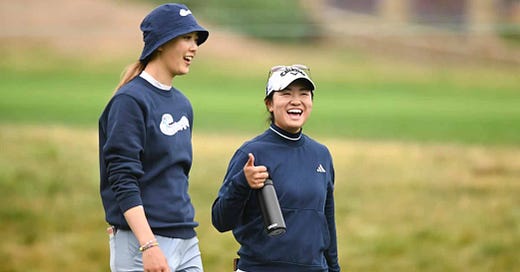At the US Open, a Beginning and an End
Rose Zhang looks to be the future of women’s golf, and the US Women’s Open could be her coming out party. It’ll also be the final tournament for Michelle Wie West.
She is unlike anything the game of golf has ever seen—more talent, more potential, more hype. They say she’s going to change the sport, that there has never been anybody quite like her. They say she’s the future.
I could be talking about Rose Zhang. Or I could be talking about Michelle Wie West. At the US Women’s Open this weekend, one era of golf will begin, and another will end. It will be Zhang’s first US Open. It will also be Wie West’s last.
Zhang arrives with the kind of hype that only Wie West might understand. She was the top-ranked amateur in the sport for more than 140 straight weeks. She won the Amateur US Open, the Amateur Master’s, and two NCAA titles. The US Open will be just her third ever professional tournament, and already, she is the runaway favorite. In her first LPGA event a month ago, she won the whole thing in a tournament hosted by—who else?—Michelle Wie West.
Twenty years ago, Wie West qualified for her first LPGA event when she was only 12 years old. When she was 14, she played against men at a PGA Tour event in Hawaii, missing the cut by only a stroke. She landed on the cover of Sports Illustrated. She was called “The Female Tiger Woods” over and over and over again.
“She’s incredible,” Zhang said of Wie West Tuesday morning.
“She’s a real competitor,” Wie West said.
Both players went to Stanford and have grown close in recent years. While in Palo Alto, Zhang would ask Wie West for advice on how to navigate school and golf (Wie West famously graduated with a 3.4 GPA). “I really hope I can be a sounding board for her,” Wie West said.
In a sport like golf, major championships act as coronations. They cement old legacies and create new ones. They’re mile markers in the long arc of a career, check in points to measure not just the passage of time but also a person’s evolution. Maybe that’s why we find ourselves using majors so often to say goodbye and to say hello.
But these waystations are rarely so tidy. At the end, often, you’ll find former heroes battered and bruised, chasing their own ghosts, as the rest of us pray for that competitive spirit to return just one more time; I’m thinking of Tiger Woods limping around Augusta earlier this year. Youngsters, on the other hand, must bide their time, fighting youth and inexperience before they can finally, truly arrive; it took Wie West 11 tries before she won the US Open.
This year’s Open is difference. The beginning and the end are so clearly marked: one legend’s race will end and another’s will begin. We’ll get to see one great wrestle with what could have been, while another tries to grasp at what might be. There’s a golf championship on the line, but really, it’s so much more than that.
Beginnings and endings. They’re always the most interesting part.
🏀 Have you watched the trailer for Goliath yet? Our new documentary about Wilt Chamberlin is out on Paramount+ on July 14.
🎾 During the Australian Open, we shared the story of Ben Shelton, whose parents met at the Australian Open decades prior. Ahead of Wimbledon, the New York Times profiles Shelton and his father, who recently left the Florida Gators to coach his son full time.
🎳 I loved this story by Eric Wills for GQ about Jason Belmonte, the two-handed bowler who changed the sport. Not everyone agrees on the way that Belmonte changed the game. PBA Commissioner Tom Clark says, “He’s exactly like Tiger Woods. The domination, the difference, the electricity, the controversy.” On the other hand, one PBA hall of famer called Belmonte a, “cancer to an already diseased sport.”
🤑 What’s the future of sports memorabilia? Sitting on your computer watching some guy open pack after pack of baseball cards. Welcome to the wild world of “box breaks.”







